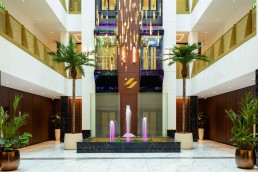
Royal Nawaab
Once a striking yet misunderstood local landmark, the long-quiet Stockport Pyramid has now found new life in a true architectural transformation. Today, this iconic structure has evolved from a dormant relic into a landmark dining destination – a restaurant where grandeur meets genuine warmth, and where the clatter of plates and laughter fills its vast, gold-toned halls.
You’ve probably heard of the Pyramids of Giza, and some of you might even know a little bit about the Pyramid of Teotihuacan. However, I wager that very few of you are aware that Greater Manchester has its very own pyramid. Tucked away just off the M60 in Stockport (the homeland of darc HQ), stands the Stockport Pyramid.
A four-sided blue-glass monument to 1990s ambition, it has loomed over the town since 1992 – residing for most of its existence in a derelict wasteland, the Pyramid is our very own “King of the Valley” despite only ever standing alone. Over the years, the building itself has split opinion: clunky, awkward, and ostentatious in every way. Yet, against all odds, the building that was once dismissed as an architectural eyesore has developed an interior to match its local iconic status.
After its original developers went bankrupt, the Pyramid stayed lonesome before being repossessed by the Co-operative Bank, who financed the original development and moved in from 1995 until 2018. Since then, the Pyramid lay dormant and derelict – until now. Today, it has been reborn as the spectacular new home of Royal Nawaab, a vast restaurant and events venue blending cultural tradition with bold, contemporary design.
At the heart of the transformation is Manchester-based design studio WDC Creative. Best known for retail and hospitality projects across the UK and Europe, the practice was tasked with reimagining the Pyramid’s cavernous interiors and creating a vision that could match the ambition of its owner, restaurateur Mahboob Hussain. From bespoke lighting installations to grand wedding halls, WDC’s design process was as much about storytelling as it was about space planning.
The studio’s involvement on the project occurred after the client had come across their work at the Carden Park Hotel in Cheshire. The project was a key turning point in the company’s portfolio. WDC helped reposition the hotel within the luxury market, redesigning facilities such as the gym, restaurant, and a new cocktail bar called Goldies. It was through their online presence that the client was struck by their work and was compelled to contact them directly.
“The client saw our work at Carden Park on Instagram and said, ‘We want what you’ve done, but bigger, bolder, and better.’ That’s how the Pyramid project began,” tells Jason West, director of WDC Creative.
The project began with a site visit to the Pyramid, untouched for more than a decade. The building was in disrepair, occupied by the ghosts of its corporate past. “When we first walked into the Pyramid, it felt as though no one had touched it for 10 years. There were old desks, cables, a huge security reception from when it was an office, almost like people had just walked out one day and left it. But beneath all that, we could see the potential. It’s an incredible space, with this vast atrium that goes right up to the top of the Pyramid. You could instantly imagine the drama of transforming it into something extraordinary,” adds West.
The client already had architects involved in planning kitchens and basic layouts, but the client wanted WDC to create the overall vision and interior concept. To do this, WDC built an enormous 3D model of the Pyramid, covering almost every space, from lobbies to wedding suites. They started with mood boards and AI-generated imagery, then developed full vitual 3D model walkthroughs to help the client, and the wider team visualise the transformation. This vision was critical for securing approvals, investment, and buy-in from stakeholders.
The transformation of the Pyramid started from the entrance. As a multipurpose event venue, the building had to be striking from the moment guests arrived. WDC designed a new gold-toned canopy to give the building a true sense of drama. Standing at two storeys high, the canopy acts as a gateway for wedding parties and a theatrical threshold for restaurant guests. Visitors then pass through the compressed tunnel clad with laser-cut metal screens that are illuminated with LED back panels before emerging into the atrium. Here, the design team layered warmth and detailing with walnut panelling, a bespoke water fountain, and cascade statement lighting. However, the most spectacular moment that draws any visitor’s attention is the atrium. Emerging from the soaring central atrium is a beautiful statement light installation, made from hundreds of glowing suspended pendants sourced from the client’s own network.
West comments: “We didn’t want it to feel like an office that had been turned into a restaurant; it had to feel completely reborn. The ambition was always to create luxury and spectacle, but never in a showy or ostentatious way. It’s about atmosphere, about theatre, when guests walk in, they should feel a sense of arrival, but also warmth.”
That balance between ambition and restraint defined the entire project. Owner and restaurateur Mahboob Hussain brought deep cultural insight and a clear vision of five-star quality; WDC translated that into built form through mood boards, samples, and immersive 3D visualisations. Every decision was collaborative, shaped by ongoing dialogue and mutual trust. Cultural authenticity remained central throughout: the design team avoided obvious motifs or clichés, instead consulting the client to ensure every pattern and detail felt respectful and true. Wherever possible, WDC and the client specified local makers and suppliers, grounding the scheme in regional craftsmanship as well as cultural meaning.
The entrance lobby, once an austere office reception, is now a hotel-style lobby complete with more bespoke lighting and coffers, rich curtains and comfortable furniture to boot – providing a calm and intimate space for restaurant visitors, while waiting for their booking. Inside, the dining hall is vast yet carefully zoned with banquettes and feature lighting by Chantelle Lighting. At its heart sits an open kitchen anchored by what is proclaimed to be the longest extraction hood in the UK.
The material palette continues the language of warmth and refinement, walnut and gold paired with marble surfaces, lifted by subtle gold accents. Lighting plays a crucial role in setting the tone, striking a delicate balance between intimacy and exuberance. The atmosphere invites private conversation yet celebrates the energy of communal dining, echoing the spirit of South Asian hospitality that brings together guests of all backgrounds from across Greater Manchester.
“When you go there now, you see such a wonderful mix of people from a wealth of different backgrounds enjoying it together. It’s brilliant,” says West.
A dynamic staircase leads to the upper levels, where weddings take centre stage. Suspended above is a bespoke chandelier of glass petals, again by Chantelle Lighting, a floral interpretation of modern grandeur. The Royal Suite, the largest of the event spaces, orients around a stage for the bride and groom, and can host hundreds of guests. Its walls are lined with illuminated fabric panels that can shift in colour or display graphics, allowing the space to flex between traditional ceremonies and contemporary corporate functions. Smaller suites on higher floors echo this adaptability, positioning the Pyramid as a multi-purpose venue for weddings, banquets and business events alike.
Turning the vision into a reality wasn’t always straightforward. Beneath the glamour of the marble, gold, and light, the project demanded significant intervention and willingness to solve problems in real time. One of the most dramatic moves was cutting through the existing floor slabs to open up sightlines and create vertical connection with an elegant staircase – a bold operation in a building defined by its geometry. “That was a big one,” recalls West. “You don’t take a saw to the Pyramid lightly.” Lighting was also part of the heart and the headache of the project. While bespoke pendants brought sparkle to the space, there were moments where lux levels were off balance or simply didn’t behave as planned.
“In hindsight, we could have brought in a lighting consultant earlier,” admits West. “We fixed it in the end, but I think there’s a lesson in that – big spaces need technical expertise.”
Yet for WDC, the project’s greatest technical achievement wasn’t just in its construction – it was the collaboration itself. The client, unaccustomed to working with external designers despite having owned a number of successful restaurants already, was forced to embrace a steep learning curve resulting in a special working relationship.
“We don’t create divides,” West explains. “We get under the skin of every client and work as part of their team. This is how the best ideas happen.”
Today, the process of refinement continues, with new wallpapers, improved signage and subtle lighting adjustments enhancing the experience. But the doors are open, and the affection long held for the Pyramid from afar can now be felt inside – perhaps best over a hot, spicy curry, if that’s your preference.
Beyond its transformation from local curiosity to grand multi-functional venue, the Pyramid’s significance runs much deeper than its physical form and is more than just a restaurant. It has become a place where people of all backgrounds and communities come together – a shared space for celebration, family and connection. During an increasingly polarising time in British society, the rebirth of the Stockport Pyramid feels both timely and hopeful: a symbol of hospitality, inclusivity and new life for one of Greater Manchester’s most recognisable landmarks.
Interior Design: WDC Creative
Architect: NK Architects
Lighting Specified: Chantelle Lighting
Images: Louis Cannell



